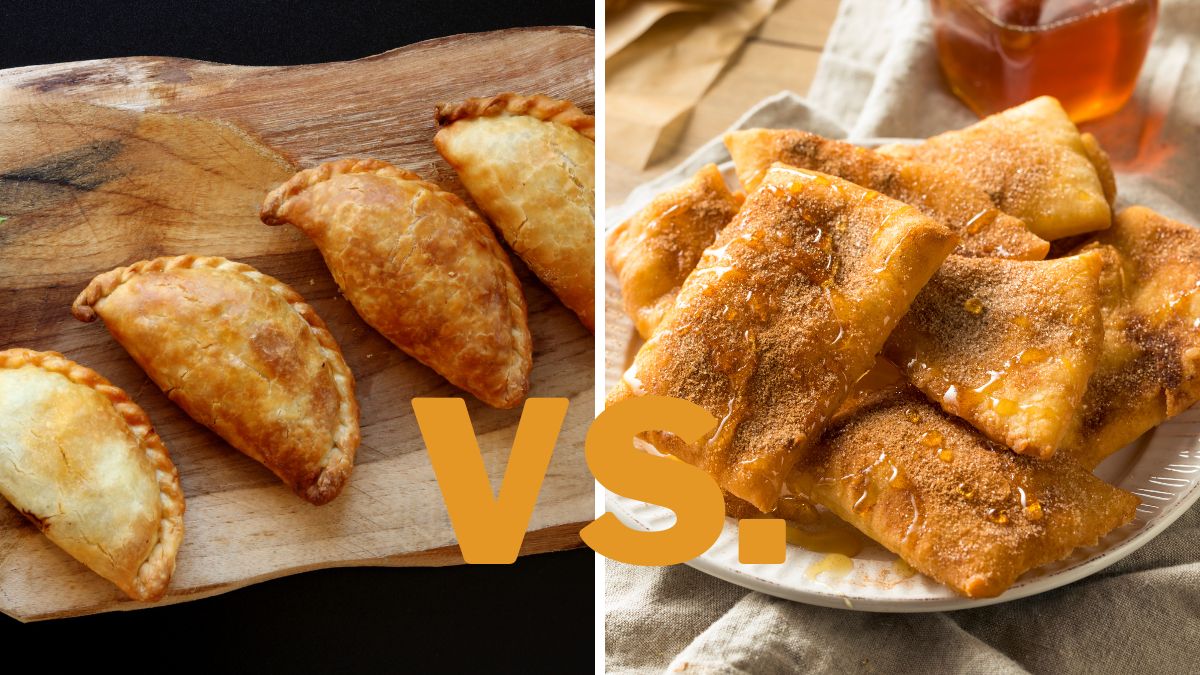Empanada vs. Sopapilla: Differences

Empanadas and sopapillas have so many similarities that you may think they are the same. Still, there are a few things that make a big difference. So, what are the main differences between empanada and sopapilla?
Empanada and sopapilla are both pastries and made of common ingredients that we all have in our pantries. Empanada is a pastry filled with many combinations, while sopapilla can be empty and coated with various sauces. Empanada is savory, and sopapilla can be both savory and sweet.
Empanadas and sopapillas remind me of big family gatherings. Making pastries at the big kitchen table for my family became a tradition and made me an expert at differentiating them. These are tasty, easy to prepare, and amazing to serve, hot or cold, which makes them my go-to dish for every occasion. Here are some differences in the filling, cooking methods, origin, and more.
Empanada vs. Sopapilla: Differences
Empanadas and sopapillas are rich-flavored pastries. One is always turnover, and the other is usually pillow-like for easier frying.
Dough, Preparation, and Filling
One of the few differences between empanada and sopapilla is the dough. Both of them require all-purpose flour and shortening/butter, though. For empanada dough, the trick is never to knead the dough with your hands.
Instead, use a fork or a pastry cutter to prevent the butter from softening. In that way, you will get a flaky/crumbly structure. When making the sopapilla dough, add baking powder and knead it with your hands, until smooth.
Traditional empanada fillings are ground meat, chicken, veggies, or cheese. The dough is ideal for combining various ingredients and putting anything you like in it.
Sopapillas are usually sweet and glazed with honey, cinnamon, caramel, or chocolate. Might fill it with fruits and cream cheese. The possibilities are endless. They can also be spicy, served with chili, cheese, salsa, or any dip you want.
Sopapilla is always deep-fried, and empanada can be either baked or fried.
Shaping and Appearance
Both empanada and sopapilla dough are simple to handle. Dough shape and stretch well with the use of a rolling pin.
Empanada has the shape of a crescent moon. You can trace its edges with a fork or twist it with your fingers. Sopapilla has a triangular shape, and it is smaller than the empanada. The rims of the sopapilla are not visible, as they are not folded but cut.
Empanadas and sopapillas are the perfect choice of finger food for any occasion. So, if you are hosting a big party or want to make your life easier, use a food processor to knead the dough instead of you. If you fancy starting small, use a pastry cutter.
An empanada mold is a handy utensil for faster filling, so you only need to fold it in half. Instead of rolling the dough, try a tortilla press.

Serving
Empanada is usually served as a main course or appetizer. Sopapilla can be an appetizer or, more likely, a dessert. Both have a clean look and are suitable for arranging nicely. They are convenient for making appetizers or dessert boards. You can serve it with fun dips or fruit.
Taste
Baked empanada has a soft, chewy structure. If you want them as crispy as fried, coat them with a yolk. The taste depends on the filling, if you like it spicy or not.
The deep-fried sopapilla is not greasy inside because of the baking powder plus, for better oil absorption put them on paper cloth. That will increase the taste of the dough. The crunchiness of the dough and the softness of the toppings make a perfect combination of textures.
Origin
Empanada originates from Spanish region Galicia. It spread to Portugal and other Southern Europe countries, Latin America, and Liberian-impacted countries. Empanada means ‘to be coated in bread’, from the Spanish word empanar.
Sopapilla is extremely popular in Latin America and is spread to Central American countries. The name sopapilla originates from the Mozarabic language of Al-Andalus. In literal translation, it means ‘bread soaked in oil.’
Nutrition
The dough alone is not the healthiest option, but if paired wisely, it will make a well-balanced meal.
When preparing empanadas, try to add a lot of vegetables and high-protein meat (like chicken or beef). Add a salad or a cup of yogurt, and enjoy. If you choose to bake them, there is no need to use oil, only baking paper.
Sopapillas can be high in sugar, so consider sprinkling them with cinnamon to balance sugar levels. [1] You can also add fresh berries, low-fat cream cheese, or greek yogurt because of the same reasons.
No gluten options – you can use non-gluten flour like rice, almond, and similar.
Variations
There are numerous variations of these meals depending on your taste. The most popular empanadas are Catalan, Chinese curry, Asian style, Mexican fried…
Chilean and Mexican sopapilla versions are the most common.
You can easily make vegan, non-dairy, and non-gluten variations by adding vegetables or tofu instead of meat and cheese, almond or rice flour instead of all-purpose.
There are so many versions of these meals with different names all over the world.
Freezing
If you like meal planning, consider making more dough and storing it. It will taste the same as the freshly made but will save you a lot of time.
When making empanadas, roll the dough in circles and pile them with baking paper in between. For sopapillas, leave the dough in a ball wrapped in stretch foil. Before use, leave it at room temperature for about 20 minutes to defrost, and roll it out regularly.
